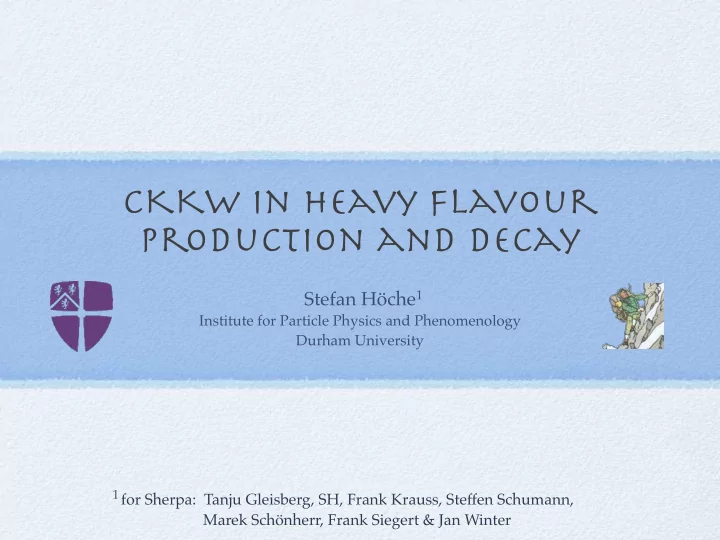

CKKW in Heavy Flavour Production and Decay 1 Stefan Höche Institute for Particle Physics and Phenomenology Durham University 1 for Sherpa: Tanju Gleisberg, SH, Frank Krauss, Steffen Schumann, Marek Schönherr, Frank Siegert & Jan Winter
PS In Heavy Quark Production In quasi-collinear limit (b heavy quark) ME factorises c z t 8 πα s a | M ( b , c , . . . , n ) | 2 → | M ( a , . . . , n ) | 2 b P a → bc ( z ) t − m 2 a t − m 2 Virtuality ordered PS evolution variable changes to t a Splitting functions become P ab ( z ) those for massive quarks Nucl. Phys. B627(2002)189 � 1 + z 2 2z ( 1 − z ) m 2 � C F q 2 + ( 1 − z ) 2 m 2 1 − z − 1 − 2z ( 1 − z ) + 2z ( 1 − z ) m 2 � � T R q 2 + m 2 Cross-check: 2- and 3-jet fraction in , PS vs. ME, weighted e + e − → t¯ t with NLL Sudakov form factors Phys. Lett. B576(2003)135 Stefan Höche, LHC-D QCD+EW, 5.7.2007
PS In Heavy Quark Production PS in production PS in decay P tt ( z ) P tt ( z ) t t’ b+X b’+X’ t t’ W W’ On-shell daughter partons Off-shell daughter partons New decay kinematics via Decay kinematics need ! Lorentz transformation to be reconstructed Choice: Boost into Choice: Reconstruct in cms new (daughter) cms of decayed quark, such FSR-like situation that is preserved → → p / | p | Evolution stops at on-shell ISR-like situation mass of heavy quark Evolution stops at width of decaying heavy quark Stefan Höche, LHC-D QCD+EW, 5.7.2007
Brief Review: Why CKKW ? Matrix Elements Parton Showers 2 2 2 + u u t + t Exact to fixed order d t t d z α s ( t , z ) � d σ n + 1 = d σ n ⊗ P a → bc ( z ) 2 π in running coupling a ∈ q , g Include all quantum Resum all (next-to) leading interferences logarithms to all orders Calculable only for low Interference effects only FS multiplicity (n ≤ 6-8) through angular ordering Basic idea of CKKW: Combine both approaches to have Good description of hard/wide angle radiation (ME) Correct intrajet evolution (PS) JHEP 08(2002)015; JHEP 11(2001)063 Stefan Höche, LHC-D QCD+EW, 5.7.2007
CKKW & Heavy Flavours Narrow width approximation full ME factorises W − into production and decay parts ¯ ¯ b t A ( n ) = A ( n prod ) A ( n i ) Schematically: � ⊗ prod dec , i i ∈ decays t W + Generator setup: AMEGIC++ provides decay chain treatment to b project onto relevant Feynman diagrams Intermediate particle masses distributed according to Breit-Wigner APACIC++ provides production & decay shower off heavy partons CKKW is applied separately and completely independent within production and each decay Yields all combinations of parton multiplicities in ME up to , i.e. 1-0-0, 0-1-0, ... in � e + e − → t¯ N max , prod ⊗ N max , dec i t i ∈ decays Stefan Höche, LHC-D QCD+EW, 5.7.2007
+ - Top production in E E + - Sanity check of procedure: Correlations in e e Reconstructed top mass Four particle plane angle Stefan Höche, LHC-D QCD+EW, 5.7.2007
+ - Top production in E E + - Sanity check of procedure: Jet differential rates in e e Q - variation in production Q - variation in decays cut cut Stefan Höche, LHC-D QCD+EW, 5.7.2007
Top Pair production @ LHC t¯ Application: production at the LHC t of pair t¯ of first extra jet t p ⊥ η Stefan Höche, LHC-D QCD+EW, 5.7.2007
Top Pair production @ LHC Cross-check: Variation of separation cut in production subprocess Differential 3 2 jet rate of first extra jet p ⊥ Stefan Höche, LHC-D QCD+EW, 5.7.2007
Top Pair production @ LHC Cross-check: Variation of separation cut in decay subprocesses Differential 3 2 jet rate of first extra jet p ⊥ Stefan Höche, LHC-D QCD+EW, 5.7.2007
Updates on Sherpa can be found on WWW.sherpa-mc.de E-mail us on info@sherpa-mc.de
CKKW Cooking Recipe JHEP 0111 (2001) 063 Define jet resolution parameter Q (Q-jet measure) cut JHEP 0208 (2002) 015 divide phase space into regions of jet production (ME) and jet evolution (PS) Select final state multiplicity and kinematics Q cut according to σ ‘above’ Q cut ∆ q ( Q cut ,Q 1 ) α s ( Q 1) ∆ q ( Q cut ,µH ) KT-cluster backwards (construct PS-tree) α s ( Q cut) ∆ q ( Q cut ,Q 1) and identify core process ∆ g ( Q cut ,Q 1 ) µ H Reweight ME to obtain exclusive samples at Q cut Start the parton shower at the hard scale q ( Q cut ,µ H ) ∆ ¯ Veto all PS emissions harder than Q ME Domain PS Domain cut This yields the correct jet rates ! Simple example: 2-jet rate in ee qq � 2 ∆( q, µ hard ) � R 2 ( q ) = ∆( Q cut , µ hard ) ∆( Q cut , µ hard ) Stefan Höche, MCnet 07, 17.4.2007
Recommend
More recommend